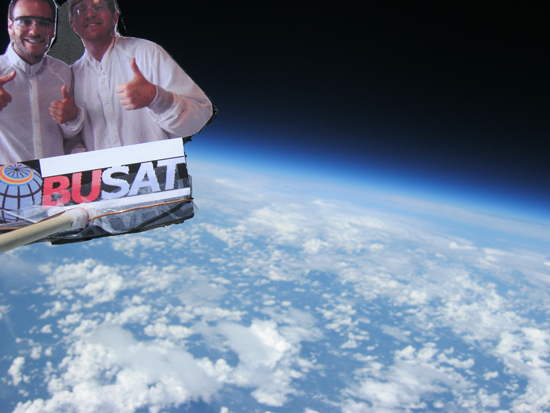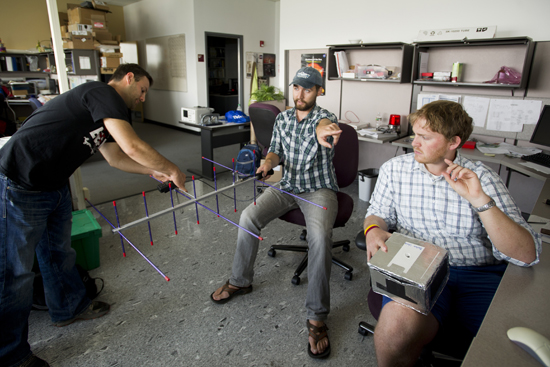Falling in Love with Science, Again
BU's RET program trains middle and high school teachers

High school teachers Fjodor Dukaj (left) and Jay Defuria superimposed on an image of the Earth taken by cameras carried by the helium balloon they launched. Photo courtesy of Jay DeFuria
Last week, high school science teachers Fjodor Dukaj and Jay DeFuria found themselves zipping along a 30-mile stretch of state highway in hot pursuit of a giant helium balloon they had just launched. Attached to its kite-like tail bobbed four boxes containing a GPS device and other equipment they and BU scientists they were working with hoped would capture images of the Earth’s curvature and measure air temperature as the balloon rose more than 18 miles into near space.
The teachers, from Somerville and Northfield Mass., felt an adrenaline rush as they approached the landing site in West Dover, Vt. “It was like chasing a tornado, just a little safer,” Dukaj recalls. Their group parked at the edge of the Green Mountain National Forest and trekked through dense foliage with a handheld antenna, called a Yagi, that blipped a tune when they headed in the right direction. The Yagi eventually sang at the base of a birch tree, where their treasure hung suspended in the branches high above. (More about that in a minute.)

Dukaj and DeFuria are among 10 middle and high school science teachers who have spent the past six weeks studying biophotonics through BU RET (Research Experiences for Teachers), a three-year, $474,000 grant-funded program sponsored by the National Science Foundation. The BU program is one of 43 RET sites across the country, many of which focus on engineering. BU’s Photonics Center provides faculty mentors, facilities, and substantial indirect funding for BU RET. The program’s principal investigators are Cynthia Brossman, director of BU’s Learning Resource Network (LERNet), which also supports the program, Michael Ruane, a College of Engineering professor emeritus of electrical and computer engineering, and Helen Fawcett (GRS’97), operations and technical programs manager at the Photonics Center.
Under the BU program, veteran teachers are paired with preservice or novice teachers and assigned to photonics labs working on a variety of projects, from using imaging sensors to detect antibodies, as in the labs of M. Selim Ünlü, an ENG professor of electrical and computer engineering, to using optics as a diagnostic test for diseases like malaria, as in the labs of Jerome Mertz, an ENG associate professor of biomedical engineering.
Beyond lab experience, teachers have weekly brown bag lunches with BU researchers, who discuss their latest work, and pedagogy sessions to explore how to integrate their new technology and research experience into the classroom. Each teacher receives a stipend of up to $7,000 and funds to buy materials for their classrooms. They return to BU three times throughout the school year to swap success stories.
Brossman says the program connects the University with the larger community and is mutually beneficial. Local teachers “are the conduit,” she says. “They’re the people through which we can share what is going on at our University with young students and hopefully inspire them to become interested in these fields.”
Sharon, Mass., middle school teacher Valerie Ordway, another RET participant, says her school days are typically spent dealing with administrative duties and catering to her students’ diverse needs, not plunging into the latest scientific discoveries. Her experience at BU, she says, is “an injection of intellectual stimulation” and an opportunity to experience what life as a scientist truly entails.
James Louis, a teacher at public high school TechBoston Academy, already knows how to incorporate his work in Mertz’s lab with his AP biotechnology lessons on sickle cell anemia, a disease not uncommon in a school where 70 percent of students are African American. When his students ask, “When will I actually apply this?” he can give them a precise response: in finding a cure.

Dukaj and DeFuria have been working with faculty and staff affiliated with Boston University’s BUSAT (Student Satellite for Applications and Training) program to produce data that will help BU researchers in designing a low Earth-orbiting satellite. Neither they nor their RET collaborator Nathan Darling (ENG’12), BUSAT project manager, had anticipated last week’s treetop rescue of their helium balloon. Darling came up with a somewhat unscientific solution: “We’re just gonna try to yank it.”
Back at the base of the birch tree the next morning, DeFuria attached fishing line to the end of an arrow, fit it into his bow, and shot it in an arc over the dangling boxes. The fifth arrow coursed the right path, and with a powerful tug to the line, the boxes fell in tandem to the ground.
“It took some time and patience,” DeFuria says, “but with a bit of maneuvering, we were able to recover everything intact.”
Darling is pleased with the experiment. The process honed his skills as an engineer interested in supporting the sciences.
And Dukaj and DeFuria couldn’t be happier: they now have a series of six affordable lab projects, all based on Massachusetts and national curriculum standards, that they can use in their classrooms. “I think this is a very feasible lab to do with the students,” Dukaj says.
Judging by the two teachers’ broad grins, it may be hard to tell who’ll be more excited about the next balloon launch—them, or their students.
RET participants will present lectures about their research today, Wednesday, August 8, from 10 a.m. to 12:30 p.m. at the Photonics Center, 8 St. Mary’s St., Room 339. Tomorrow they will host a poster session from 3 to 5 p.m. in the center’s seventh floor atrium. The presentations are free and open to the public.
Comments & Discussion
Boston University moderates comments to facilitate an informed, substantive, civil conversation. Abusive, profane, self-promotional, misleading, incoherent or off-topic comments will be rejected. Moderators are staffed during regular business hours (EST) and can only accept comments written in English. Statistics or facts must include a citation or a link to the citation.